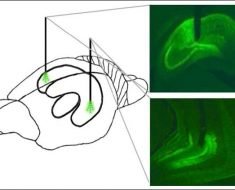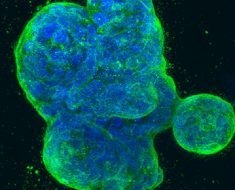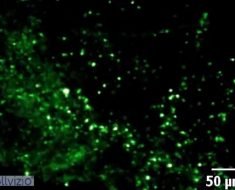Cancer often picks up genetic changes that allow it to resist treatment. But this takes time. How do cancer cells undergoing drug treatment survive long enough to evolve? To answer this question, a study presented at the American Association for Cancer Research (AACR) Annual Meeting 2018 used real-time, single-cell imaging to make movies of live cancer cells responding to treatment with an anti-cancer drug. All cells stopped dividing in response to the drug, as expected. And then within 2-3 days, some cells restarted. By rewinding the tape of the cells that tolerated therapy – effectively, playing the movie in reverse – researchers examined how cells are able to evade drug action, long before they have acquired drug resistance mutations.
The study, led by Sabrina Spencer, PhD, investigator at the University of Colorado Cancer Center and assistant professor in the CU Boulder Department of Chemistry and Biochemistry, worked with melanoma cells harboring BRAF-V600E mutation. In many ways, these cells are an iconic example of cancer driven by a single, known mutation. Hyper-activation of the BRAF gene starts the cancer, and the FDA-approved BRAF-inhibitor dabrafenib stops it. That is, for 6-7 months, at which point BRAF-V600E melanoma tends to develop resistance to dabrafenib.
When melanomas hyper-activate BRAF, the gene turns on a pathway that drives proliferation, called the MAPK pathway. But hyper-activation of BRAF isn’t the only way to hyper-activate proliferation. Sure enough, melanomas with the BRAF-V600E mutation that become resistant to dabrafenib can do so by reactivating Mek, a component of the MAPK pathway. (The FDA recently approved combination treatment in BRAF+ melanoma, using dabrafenib against BRAF and trametinib against MEK to delay this escape.)
But, again, melanoma needs time to acquire mutations that reactive the MAPK pathway or, for that matter, any other genetic escape route. Dabrafenib should eliminate melanoma cells before they can evolve this escape. But some cells survive.
“What we’re looking at here is the immediate response of melanoma cells to BRAF inhibitor treatment, in real time, over the first few days of treatment. Not genetic changes, but the mechanisms the cell uses to evade treatment and start dividing again in a matter of a few days,” Spencer says.
She watches this evasion with a new technique known as single-cell time-lapse microscopy and MATLAB-based automated cell tracking, which is, very basically, a way to keep a microscope pointed at a single cell and stitch its actions into a time-lapse movie (although Spencer suggests the actual technique may be bit more complicated than that).
Before treatment with the drug, cells were replicating on a cycle of about 14 hours. When Spencer and her PhD student Chen Yang introduced dabrafenib, the cells stopped replicating, entering a kind of suspended animation known as quiescence. Then about 72 hours later some cells woke from quiescence and started replicating again. At any point during the course of the following week, about 10 percent of these treated cells continued to actively replicate.
“In other words, ten percent of these cells had somehow tolerated this treatment that should have kept them in check,” Spencer says.
Analysis showed that these cells that tolerated dabrafenib had somehow reactivated the MAPK signaling pathway within 2-3 days.
“Our next question is what could be causing this MAPK reactivation,” Spencer says. One candidate was, of course, MEK. And when Spencer performed the same experiment with the combination of dabrafenib and the MEK inhibitor trametinib, no cells escaped to continue replicating.
“What we find is that dabrafenib, even at high doses, does not fully turn off the MAPK pathway, thereby enabling eventual escape from drug,” Spencer says.
Source: Read Full Article





